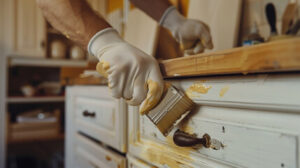Cabinet Refinishing Modesto Anchor is a quick and easy way to transform your kitchen’s aesthetic. It is ideal for a complete aesthetic overhaul and is much more affordable than replacing the cabinets.

Start by removing cabinet doors and drawer fronts and labeling each piece for easy reassembly later on. Then, cover appliances and backsplashes with plastic and tape to protect them from stains.
Before you start painting or staining, the cabinets must be thoroughly cleaned. The process typically involves spraying a degreaser solution or using a stronger cleaner such as trisodium phosphate (TSP), which is available at hardware stores and paint shops, to remove grease and grime that could prevent a smooth finish. You may also need to sand the existing surfaces to scuff them, which helps the new finish adhere.
When refinishing, you can choose from a variety of colors and finishes. High-quality finishes not only enhance appearance, but also protect the cabinets from moisture and daily wear and tear. The refinishing process requires more work than refacing, but is a good option for homeowners with limited time and budget who prefer to keep their cabinet style intact.
Both processes can improve a kitchen’s look, but each offers a different level of change and transformation. When considering your options, consider your long-term goals for your home. If you plan to sell your house in the future, refacing might be more effective for increasing resale value.
Refacing is a more comprehensive update that changes the look and feel of your kitchen. It is ideal for homeowners who want to completely revamp their kitchen and add modern features, such as soft-close hinges and sleek handles. It is less cost-effective than refinishing, but it can still make a significant impact on your home’s value.
When refacing, you can change the color, door style, and hardware to give your kitchen a fresh and updated look. Refacing can also be more practical than refinishing, especially for homeowners who have older or damaged cabinetry that is structurally sound but worn and outdated. Before you start, you’ll need to clean the cabinets thoroughly and prepare them for installation. You may need to reattach the doors and drawers, and you’ll likely need to reinstall the cabinet hardware, such as knobs and hinges. Once the cabinetry is installed, you can apply a clear coat to protect it and add a glossy finish. You’ll need to wait for this to dry before you can use your cabinets again.
Sanding
Cabinet refinishing is a cost-effective way to transform your kitchen. However, it requires a significant time commitment and patience to get the best results. To avoid any hiccups along the way, you should carefully assess your budget constraints and long-term kitchen plans before beginning this project. The key to a successful project is the sanding process, which prepares the surface for a new finish. This is done by removing any existing paint, stain, or varnish to expose the natural beauty of your cabinets.
To start, use coarse sandpaper to strip away the old layers of paint or varnish. This step is necessary to ensure the new finish adheres properly. Once this stage is complete, medium sandpaper can be used to smooth the surface. It is important to sand in the direction of the wood grain to prevent damage or gouges in the cabinet. The final stage involves using fine sandpaper to achieve a polished surface. The right sandpaper type will depend on your cabinet material, as different species have varying hardness and density.
When choosing sandpaper for your cabinet project, consider a flexible option that adapts to curves and corners. A sanding sponge can be the perfect solution, as it provides both flexibility and durability to tackle the most challenging areas. The flexible material allows the sandpaper to conform to the surface and remove any imperfections for a flawless finish. Once the sanding process is completed, the cabinet can be prepped for a fresh coat of paint or stain.
If you are going to stain your cabinets, it is important to choose the correct type of stain for the material. Water based stains are ideal for pine and soft woods, while gel stains are suitable for all types of hardwoods. Whether you are refinishing or refacing your cabinets, be sure to select a high-quality stain to protect the new surfaces from moisture and daily wear.
Once the stain is dry, you can reinstall the cabinet doors and drawers. Be sure to refer back to your labeling system, so you return each piece to its proper location. You may also want to add new hardware for a more finished look.
Primer
Before you can start putting the finishing touches on your cabinet refinishing project, you need to prime. This is a crucial step that helps paint adhere properly and hide any flaws in the surface of your cabinets. For best results, use a primer that is compatible with your chosen paint or varnish. In addition to enhancing adhesion, the right primer can also help protect your kitchen cabinets from moisture and staining.
While skipping this step might seem like an easy way to save time, priming your cabinets is vital for a high-quality finish that looks beautiful and lasts. Without this foundation, your newly painted cabinets are at risk of bubbling, peeling and discoloration. In addition, unsealed wood absorbs moisture easily, which can lead to swelling and warping. Using a water-based primer with stain-blocking properties helps seal the pores of the wood, making it resistant to moisture.
You can choose from a variety of primers depending on the type of cabinet materials you’re painting. If you’re refinishing hardwood or plywood, a stain-blocking shellac primer is ideal. This quick-drying primer can be used over bare wood and existing painted surfaces. It also has excellent adhesion and can be tinted to match your final shade of paint.
If you’re refinishing drywall or plaster, a latex primer is the best choice. This primer offers great coverage, has low odor and is mildew-resistant. For best results, apply the primer in a well-ventilated area to avoid excessive fumes.
After priming, it’s important to make sure that the surface of your cabinets is completely clean. Use a degreasing cleaner or trisodium phosphate (TSP) to remove any grease and grime. Then, rinse the cabinets with a damp sponge or cloth. Once the surface is dry, you’re ready to begin the sanding process. Light sanding is all that is needed to rough up the surface for proper adhesion of your paint or varnish. Be sure to sand the edges of your cabinets, as this is where most chipping occurs. Once your cabinets are sanded, wipe down the surfaces with a damp sponge to remove any leftover cleaner residue and let them dry thoroughly.
Paint or Varnish
Cabinet refinishing is one of the most cost-effective ways to give your kitchen a fresh new look. The process typically involves resanding the cabinet surfaces and then painting with a new color of your choice. If your cabinets are old or outdated, you may need to replace the hardware as well. This can be a costly upgrade, so it is important to consider your options carefully.
The refinishing process can take time and patience, but it is worth the effort in the end. It is important to prepare the surface properly before beginning and to use a high-quality paint or varnish for long-lasting durability.
There are several different kinds of varnishes available, and they all offer a unique set of benefits. Some are designed to provide a more matte finish, while others are intended for higher sheens and added protection. Varnishes are also often formulated to resist discoloration from humidity and heat, as well as from exposure to visible and UV light sources.
When applying a new coat of varnish, it is best to apply two coats for the most even and smooth finish. You can apply the first coat with a brush, spray gun, or a tiny foam roller (low pile). Be sure to allow sufficient time for the varnish to dry between coats. Avoid using a fan to speed up the drying process, as this can blow dust around and can cause spots or streaks in the final finish.
